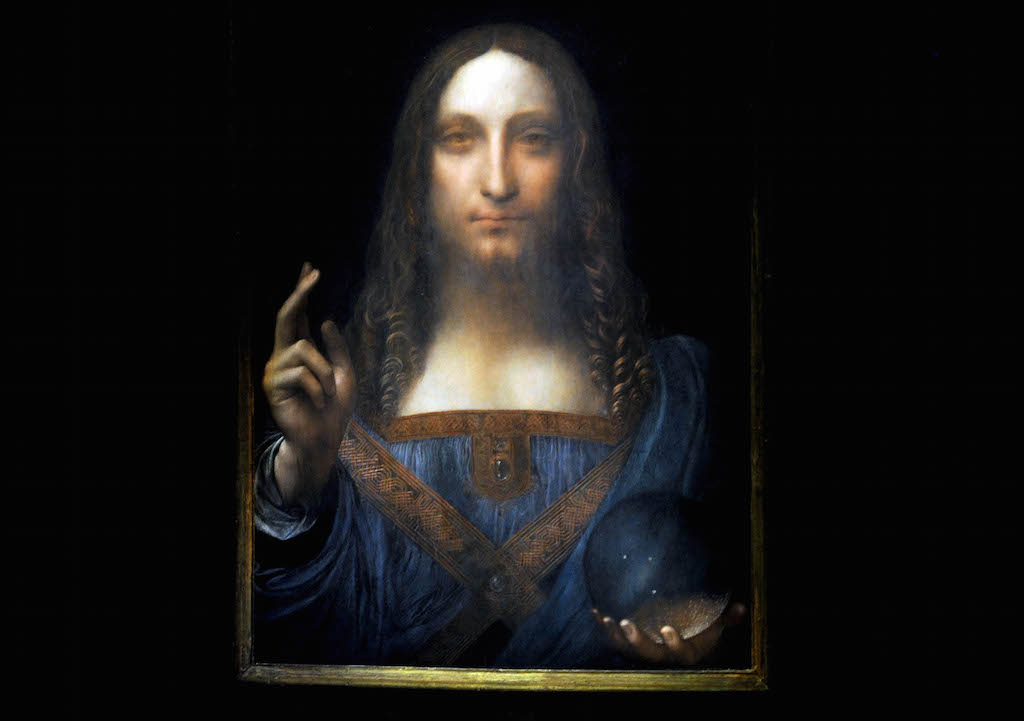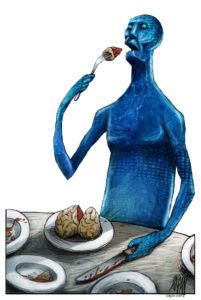Experts Not Sold on $450 Million Price for a Work by Leonardo
Art adviser Todd Levin called the Christie's auction sale of “Salvator Mundi" an "epic triumph of branding and desire over connoisseurship and reality." Leonardo da Vinci's “Salvator Mundi," or "Savior of the World," followed a long and bumpy path to its record-setting sale. (Dennis Van Tine / Star Max)
Leonardo da Vinci's “Salvator Mundi," or "Savior of the World," followed a long and bumpy path to its record-setting sale. (Dennis Van Tine / Star Max)
Leonardo da Vinci’s “Salvator Mundi” (“Savior of the World”) sold for $450.3 million at Christie’s on Wednesday, setting an auction record. The figure shatters the previous record, for Picasso’s “Women of Algiers,” which changed hands for $179.4 million in May 2015.
“Salvator Mundi”—probably painted in 1500 and rediscovered in 2005—is a rare work by the maestro who made only about 16 paintings in total. Even more rare is the stellar sales price for an old master at a time when that sector of the art market is contracting. The anonymous purchaser acquired what is regarded as Leonardo’s last known painting still in private hands.
The price surprised many experts because of the painting’s poor condition and some question about its origin. The New York Post reported:
At 200 years old, the painting had likely begun to show its age, and unsophisticated restorationists began filling in cracks in the wood with putty and attempting to touch up the masterwork.
“It may have had heavy overpaint on it even in that time,” Wintermute [Alan Wintermute, a Christie’s vice president and specialist in Old Masters paintings] said of its days hanging in the future epicenter of British monarchy.
But it was still recognizable as a Leonardo in 1763, when Sheffield’s son, Sir Charles Herbert Sheffield, sold it as “L. Da. Vinci A head of our Saviour.”
It went for the equivalent of about $500 in today’s money.
The painting disappeared for 150 years, and when it re-emerged, it was nearly unrecognizable thanks to maladroit touchups that obscured Leonardo’s masterful hand. …
Critics of the work say the painting’s hazy pedigree and high level of retouching make it practically worthless, in their opinion.
“There’s so little of Leonardo there. From a commercial standpoint, I don’t think it has any value. I wouldn’t buy it at any price,” gallerist Richard Feigen told The Post, adding when pressed: “Well, $10 I could do.”
Some attribute the stratospheric sales price to Christie’s aggressive marketing campaign, opening the doors to roughly 27,000 visitors in Hong Kong, London, San Francisco and New York in the days leading up to the auction and producing a video featuring fans gawping at the painting dubbed “The male Mona Lisa”:
Art adviser Todd Levin did not mince words. “This was a thumping epic triumph of branding and desire over connoisseurship and reality,” he told The New York Times.
Experts are often able to guess the identity of an anonymous buyer based on tastes and habits, but few pretend to know who is the new owner of “Salvator Mundi.”
With a varied history that dates to Louis XII of France and later hanging in Buckingham Palace during the reign of Charles I, the painting was believed lost for 150 years. In the 1950s it sold at Sotheby’s as a work by Italian artist Giovanni Antonio Boltroffio for the equivalent of $90. In 2011, it went on display at the National Gallery in London and was officially designated a Leonardo, quieting some of the murmurs that it had been partially painted by an assistant. It was probably the work’s first public display and, now that it is in private hands, could have been among its last.
There is always hope that the new owner will lend it to a museum for exhibition, but the odds are that he or she won’t. It might even be donated, a move that, surprisingly, would decrease the likelihood the public would ever see it, according to a report from Quartz Media.
Much of the world’s great art is housed in the vast archives of museums with limited display space. The largest museums typically display about 5% of their collection at any time. Wealthy patrons who donate art to these museums often end up hiding it from public view. …
Artists, collectors, and foundations donated the vast majority of the art represented in this survey. In addition to the potential tax write-off, benefactors often view large museums as the only places that can guarantee important works of art will be properly conserved. They may also seek out institutions that have a policy of never selling the work, as the Rothko Foundation did with the NGA.
As a result, art tends to accumulate in the storage vaults of big museums rather than the galleries of smaller ones. Moreover, the roughly 5% of their collections that museums do display is usually rotated among the most culturally important works they have. Less significant or niche works may never leave the archives except to be conserved. A 2002 dissertation found that at the Fine Art Museums of San Francisco, which are included in our survey, donated items were displayed much less frequently than purchased ones.
If mathematician Alfred North Whitehead was right when he said, “Art attracts us only by what it reveals of our most secret self,” then the record-setting sale of “Salvator Mundi” and the sequestering of masterworks speak unflattering volumes.
Your support matters…Independent journalism is under threat and overshadowed by heavily funded mainstream media.
You can help level the playing field. Become a member.
Your tax-deductible contribution keeps us digging beneath the headlines to give you thought-provoking, investigative reporting and analysis that unearths what's really happening- without compromise.
Give today to support our courageous, independent journalists.






You need to be a supporter to comment.
There are currently no responses to this article.
Be the first to respond.